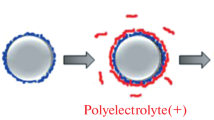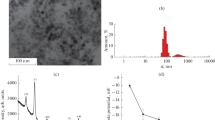Abstract
Dielectric measurements were carried out for polystyrene microcapsules which were prepared by means of an interfacial polymer deposition technique. The microcapsules showed a couple of dielectric relaxations termedP for lower andQ for higher frequencies. The frequency profiles were characteristic of the structure that shelled spheres were dispersed in a continuous medium. Gelatin aqueous solutions, cationic polyelectrolyte solutions and distilled water were loaded in the capsule interior to examine the effect of conductivities of the constituent aqueous phases on the dielectric properties. Relaxation frequencies of the relaxationsP andQ observed were directly proportional to the conductivities of the continuous medium and of the capsule interior, respectively. A dielectric theory was proposed for a suspension of shelled spheres in a continuous phase in order to analyze the relaxation data observed for the microcapsules. Volume fraction of the capsules, relative permittivity and conductivity of the capsule interior and thickness of the capsule wall are evaluated from the dielectric observations by use of the theoretical formulas derived. The dielectric behavior observed for the polystyrene microcapsules are interpreted quantitatively in terms of the dielectric theory proposed.
Similar content being viewed by others
References
van Beek, L. K. H., Dielectric Behavior of Heterogeneous Systems in “Progress in Dielectrics”, Vol. 7, p. 69, ed. J. B. Birks, Heywood Books, London (1967).
Hanai, T., Electrical Properties of Emulsions in “Emulsion Science”, Chap. 5, p. 353 ed. P. Sherman, Academic Press, London-New York (1968).
Dukhin, S. S., Dielectric Properties of Disperse Systems in “Surface and Colloid Science”, Vol. 3, p. 83. ed. Egon Matijevic, Wiley-Interscience, New York-London (1971).
Dukhin, S. S., V. N. Shilov, Dielectric Phenomena and the Double Layer in Disperse Systems and Polyelectrolytes, John Wiley & Sons, New York-Toronto-Jerusalem (1974).
Hanai, T., N. Koizumi, R. Gotoh, Kolloid Z.167, 41 (1959).
Hanai, T., N. Koizumi, T. Sugano, R. Gotoh, Kolloid Z.171, 20 (1960).
Hanai, T., Kolloid Z.177, 57 (1961).
Hanai, T., Kolloid Z.171, 23 (1960).
Hanai, T., Kolloid Z.175, 61 (1961).
Asami, K., T. Hanai, N. Koizumi, J. Membrane Biol.28, 169 (1976).
Asami, K, T. Hanai, N. Koizumi, J. Membrane Biol.34, 145 (1977).
Asami, K., T. Hanai, N. Koizumi, Biophys. J.31, 215 (1980).
Irimajiri, A., T. Hanai, A. Inouye, Biophys. Structr. Mechanism1, 273 (1975).
Pauly, H., L. Packer, H. P. Schwan, J. Biophys. Biochem. Cytol.7, 589 (1960).
Schwan, H. P., Electrical Properties of Tissue and Cell Suspensions in “Advances in Biological and Medical Physics”, Vol. 5, p. 147, ed. J. H. Lawrence and C. A. Tobias, Academic Press, New York (1957).
Hanai, T., K. Asami, N. Koizumi, Bull. Inst. Chem. Res., Kyoto Univ.57, 297 (1979).
Tateno, A., M. Shiba, T. Kondo, Emulsions, Latices and Dispersions, p. 279. ed. P. Becher, M. N. Yudenfreund, Marcel Dekker Inc., New York (1978).
Ishikawa, A., T. Hanai, N. Koizumi, Japanese J. Appl. Phys.20, 79 (1981).
Asami, K., A. Irimajiri, T. Hanai, N. Koizumi, Bull. Inst. Chem. Res., Kyoto Univ.51, 231 (1973).
Schwan, H. P., Determination of Biological Impedances in: “Physical Techniques in Biological Research” Vol. 6, Part B, Chap. 6, p. 373, ed. W. L. Nastuk, Academic Press, New York-London (1963).
Pauly, H., H. P. Schwan, Z. Naturforschg.14b, 125 (1959).
von Hippel, A. R., Dielectric Materials and Applications, p. 336. John Wiley & Sons, New York-London (1954).
Clark, F. M., Insulating Materials for Design and Engineering Practice, pp. 508–528. John Wiley & Sons, New York-London (1962).
Wagner, K. W., Arch. Electrotechn. (Berlin)2, 371 (1914).
Author information
Authors and Affiliations
Rights and permissions
About this article
Cite this article
Zhang, H.Z., Sekine, K., Hanai, T. et al. Dielectric observations on polystyrene microcapsules and the theoretical analysis with reference to interfacial polarization. Colloid & Polymer Sci 261, 381–389 (1983). https://doi.org/10.1007/BF01418210
Received:
Accepted:
Issue Date:
DOI: https://doi.org/10.1007/BF01418210




